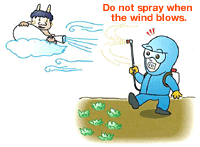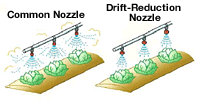Safe Pesticide Spraying
As a leading manufacturer of pesticide applicators, Maruyama understands how important it is to supply equipment that allows pesticide to be sprayed safely, and without affecting the health of the sprayer. Society today is much more aware of the effects of agricultural chemicals not only on people, but also on the environment. Pesticides and spraying equipment must therefore guarantee higher levels of safety than ever before. Maruyama also recognizes that the risk of agricultural chemical "drift" during spraying is a serious issue, and works actively with concerned organizations to devise measures to reduce this risk.
Why is agricultural chemical drift a problem?

When agricultural chemicals are sprayed, they sometimes land on areas that were not the target of spraying. This is known as "drift". The problem with drift is that neighboring residents and crops might be adversely affected by the agricultural chemicals to which they have been exposed, or that the the chemicals might get mixed into public waterways. Concerns about drift and chemical residue have also been heightened following the passage of the amended Food Sanitation Law in 2006. This law introduced a positive list system for agricultural chemical residues and reduced the uniform limit to a very low 0.01 ppm for chemicals for which maximum residue limits have not been established.
Agricultural chemical drift can therefore be seen as problematic from several viewpoints.
Major causes of agricultural chemical drift
- Weather conditions: Drift occurs more easily in windy conditions. The stronger the wind, the further the chemicals drift.
- Agricultural chemical form: Chemicals in powdered form drift more easily.
- Particle diameter: Fine-grained particles drift more easily .
- Reachability: Drift occurs more easily when using spraying methods devised to spread the chemicals further.
When using applicators that include blowers, the higher the blower setting, the further the chemicals drift. - Nozzle control: Drift occurs more easily the further away the nozzle is from the crop, and if the nozzle is swung about.
(Excerpt from Manual of Technological Measures for the Safe Spraying of Agricultural Chemicals)
Measures to prevent drift
General measures

- Spray only when the wind is not strong, and be aware of the wind direction.
- Be careful with the spraying direction and location.
- Spray using an appropriate nozzle and the correct pressure.
- Use the correct spray volume.
- Clean the spraying equipment after use.
Measures for different types of spraying

- Spraying with liquids Use a drift-reduction nozzle
> Eco Shower
Maruyama Drift-Reduction Nozzle
- Spraying with dust Change the form: Microgranule F (link to Japan Plant Protection Association website)
> Dedicated hose (Ecomaki Hose) - Spraying with a speed sprayer Perform spraying by adjusting the blast volume and spray movement and respray areas that have been missed.
- For high-clearance boom sprayers, Maruyama has demonstrated proven drift reductions in rice fields by implementing high-density low-volume spraying (25 L/10 a).
Other measures
- Use shield nets, crop shelters, and other shielding materials
- Use low-impact agricultural chemicals ? Chemicals that come in a form that does not easily drift (granular), biological agrochemicals, etc.
Links
- Ministry of Ministry of Agriculture, Forestry and Fisheries (Manual of Technological Measures for the Safe Spraying of Agricultural Chemicals)

